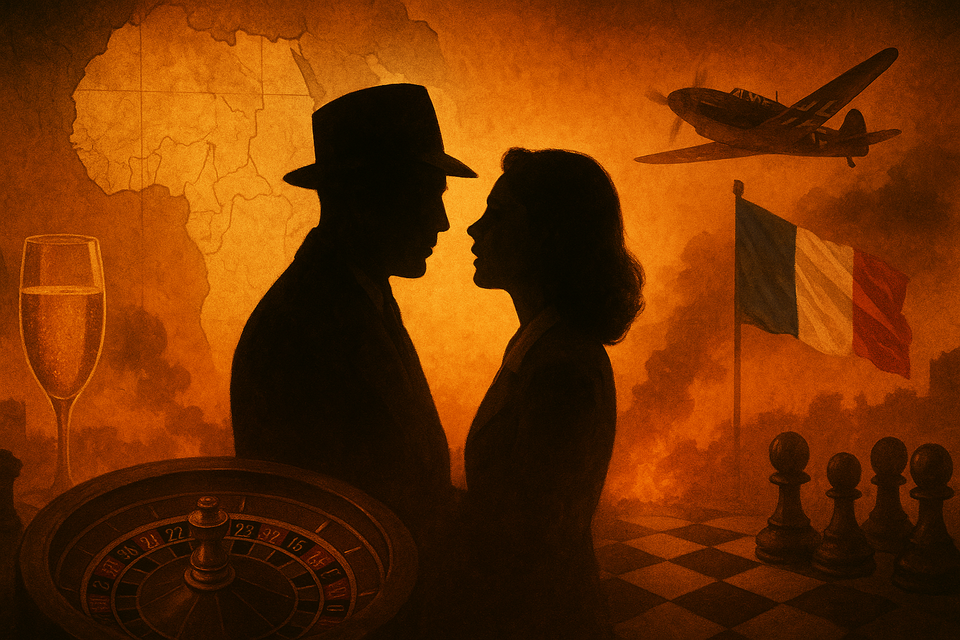Casablanca (1942): Duty in Disguise

Michael Curtiz’s Casablanca has long been crowned one of cinema’s great romances, a story of longing and sacrifice set against the smoke and shadows of Rick’s Café. Watched today, the love story may not unfold with the psychological realism of later films, yet it retains a peculiar force. The triangle of Rick, Ilsa, and Lazlo works less as intimate drama than as emblem, a structure designed to carry the weight of war. Released in 1942, with America newly committed to battle, Casablanca turns private desire into public fable. Rick’s hardboiled detachment is less about his character than about a nation reluctant to intervene; Ilsa’s torn loyalties embody the pull between personal longing and duty; Lazlo’s nobility is propaganda in human form. The romance gives the allegory its pulse, ensuring that sacrifice feels not only necessary but heartbreakingly human.
Players as Emblems
The film’s endurance also rests on its cast, who embody not just characters but positions in a larger fable. Humphrey Bogart, making the leap from gangster roles to reluctant romantic lead, gives Rick his weary restraint — every line clipped, every gesture measured, the weight of principle tucked behind cynicism. Ingrid Bergman lends Ilsa a glow that surpasses the script’s shifts; her performance supplies the coherence the plot withholds, her face alone convincing us that this is love worth grieving. Paul Henreid plays Victor Lazlo with stiff nobility, less a man than a monument, and that very stiffness makes him function as the resistance incarnate. Claude Rains brings sly wit to Captain Renault, a portrait of opportunism that can tilt toward either collaboration or friendship depending on who holds the upper hand. And Conrad Veidt, once an exile himself, sharpens Major Strasser into a Nazi cut from propaganda cloth — blunt, menacing, and essential as the shadow everyone else is defined against.
Rick and the Nation
Rick’s story only makes sense when read against history. His café is a neutral zone, and he insists on neutrality himself — “I stick my neck out for nobody.” Yet the film seeds reminders that this aloofness is a retreat, not his nature. We learn he once fought for Ethiopia against Mussolini, once stood with the loyalists in Spain. He was a man of causes who chose withdrawal, just as America had pulled back between the wars. By setting the film in December 1941 — the month Pearl Harbor forced that stance to end — Curtiz makes Rick the nation in miniature: principled at heart, but slow to act, and suddenly faced with the impossibility of standing aside. His final choice is less a conversion than a return, a rediscovery of what he had abandoned. When he pulls the trigger on Strasser and engineers Lazlo’s escape, the gesture is at once personal and geopolitical. Rick becomes again the champion of the underdog, and with Renault at his side, the film suggests even compromised allies can be reclaimed. The famous “beautiful friendship” closes not only a story but an argument: neutrality must give way to action, and sacrifice can be framed as both noble and inevitable.
Craft as Allegory and Emotion
If the performances anchor the allegory, the craft gives it shape — and infuses the romance with its enduring ache. Music carries the heaviest weight: “La Marseillaise” swelling to drown out German voices becomes less a scene than a manifesto, a moment when art insists the collective will can overpower occupation. Yet even “As Time Goes By,” played on Sam’s piano, works not simply as a love theme but as a bridge between memory and loss, the refrain that binds Rick and Ilsa to what they cannot reclaim. Visual motifs echo the same doubleness. Rick plays chess against himself, a solitary man rehearsing battles in isolation, but also a nation caught between self-interest and responsibility. Champagne flows constantly, sparkling against the backdrop of war, its frivolity doubling as a shorthand for joy that cannot last. Even the roulette table becomes allegory, when Rick rigs the wheel to free a young couple from corruption; luck bends only when principle guides it. These devices do not build the romance as realism, but they give it weight as symbol — gestures that allow audiences to feel its ache even when the psychology is schematic.
Flaws and Risks
Still, the seams show. The romance, while effective as symbol, does not always persuade as lived experience. Ilsa’s choices swing from devotion to self-denial to sudden reversals, more in service of the plot’s needs than consistent character logic. Rick’s passion in Paris, his bitterness in Casablanca, and his final sacrifice all work cleanly as allegory, but as private emotion they can feel compressed. Lazlo, for all his symbolic force, remains marble rather than flesh. Even the Paris flashback — champagne flowing, love unspooling just before invasion — plays more like shorthand than lived intimacy. Yet these weaknesses do not diminish the film so much as reveal its purpose: Casablanca was less about plumbing psychology than about creating emblems. Its romance was meant to be felt, not dissected, a vessel for the weight of sacrifice at a moment when the world was being asked to give.
Verdict
For decades, Casablanca has been enshrined as cinema’s great romance, the story of Rick and Ilsa standing for every doomed affair since. Seen up close, the love story is less persuasive as private drama than as emotional shorthand, made powerful through performance, music, and symbol. What gives the film its endurance is not its tears alone but its timing. Made in 1942, set in December of 1941, it transforms one man’s sacrifice into a portrait of nations rediscovering their principles. Rick’s journey from isolation to action mirrors America’s, and every flourish of music, every glass of champagne, every turn of the roulette wheel reinforces that larger fable. If the romance leans more on atmosphere than realism, it remains potent because it channels the emotional weight of an era. On balance, the film deserves its place — not as the greatest love story ever told, but as one of the most elegant acts of wartime persuasion Hollywood ever produced. Recommended; three and a half stars.



Comments ()